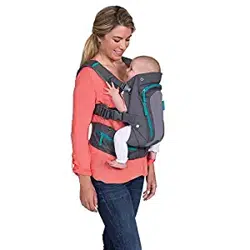Loading ...

3.
• NEVER place more than one child in this carrier.
• DO NOT wear more than one carrier at a time, ever.
• DO NOT use in showers, pools, or any water environments.
For Safe and Secure Carrying:
If you are new to babywearing or are using a new carrier style, there are denitely some things you need to
know before placing your baby in the carrier. Here are some important Dos and Don’ts for proper use of your
carrier. Please be sure to review this manual in its entirety for all safety information.
• Practice before you start. Be sure to try out your carrier before you put baby in the rst time.
• Check regularly that baby’s chin is positioned upwardly and never pressed into his/her chest.
• Don’t overdress your baby. Your closeness and body heat along with the carrier fabric will help to keep them warm.
• TIP: Small children have poor temperature regulation, so check baby’s abdomen, forehead, and neck frequently.
• Check your baby’s legs often to make sure they are warm and blood circulates freely. Should the calves and
feet appear to be a slightly different color, shift baby in the carrier.
•If baby falls asleep or starts to fuss in the Facing-Out position you should switch to the Facing-In position or
remove them from the carrier entirely.
Carry on multi-pocket carrier™ Position Options
Position: Facing-In with
Folded Seat
Facing-In with
Expanded Seat
Facing-Out with
Folded Seat
Back Carry with
Expanded Seat
Ag
e:
For babies 8 lbs
to 15 lbs (3.6 kgs
to 6.8 kgs)
For babies 15 lbs
to 40 lbs (6.8 kgs
to 18.2 kgs)
Baby is able to
hold their head up
on their own
Baby is able to fully
sit up on their own
Tips:
Until your child
is able to hold
his/her head
upright, this is the
correct position.
When the baby
is positioned
correctly, you
should be able to
tilt forward slightly
and kiss the top
of your child’s
head.
The wide seat
allows a larger
baby to ride in a
seated position
with his/her
legs wrapping
around you. This
is a comfortable
position for
the child and it
provides better
weight distribution
for you.
Never use the
wide seat when
baby is Facing-
Out. This position
allows your baby
to visually explore
their surroundings
while maintaining
close contact with
you.
This position
requires assistance
from a second
person. Wearing
the carrier closer
to your body and
higher up on your
back will minimize
stress on your back
and shoulders from
prolonged use.
Instructions:
see pg. 6 see pg. 10 see pg. 14 see pg. 17
4.
Helpful Hints:
• Facing-In Position - Baby Facing Toward You - Until your child is able to hold his/her
head upright, this is the correct position. It affords your baby lots of close physical
contact and attention, while leaving your hands free. In this position, you can entertain
and bond with your newborn by talking, touching, playing or just making eye-contact.
• Facing-Out Position - Baby Facing Away From You - Once your child is able to hold
his/her head up, your baby is ready for a new adventure. This position allows him/her to
visually explore their surroundings while maintaining close contact with you. Always use
the narrow seat position when carrying in the baby facing-out position.
• Back Carry Position - Child Facing Towards You - When your little one can fully sit
up on his/her own, putting them on your back allows you to carry the child comfortably
for longer periods of time. In this position your baby is free to check out what is going on
around them and still know that you are right there.
What seat position should I use?
• For Facing-In Position, smaller babies, 8 lbs to 15 lbs, use the Folded Seat. Larger
babies and children use the Expanded Seat. The Expanded Seat allows a larger
child to ride in a comfortable seated position with their legs wrapping around you.
• For Facing-Out Position, always use the Folded Seat.
• For Back Carry Assisted Position, always use the Expanded Seat.
How do I know if my baby is at the right height when carrier is worn in the front?
•You should be able to tilt forward slightly and kiss the top of your child’s head.
• When placing your baby in or taking them out of the carrier, sitting down will make
the procedure easier. Until you are familiar with the placement of baby, it is also
recommended to do so over a soft surface.
• It is best to limit the use of your carrier to 10-20 minutes until you and your baby are both
completely comfortable in it together.
• Wearing the carrier closer to your body and higher up on your back (or chest when worn
in the front position) will minimize stress to your back and shoulders from prolonged use.
Care Instructions:
Machine wash cold, separately, on gentle cycle with mild detergent. DO NOT bleach. Wipe
clean with a cloth or sponge between machine washings. Drip dry only. DO NOT iron.
Loading ...
Loading ...
Loading ...
